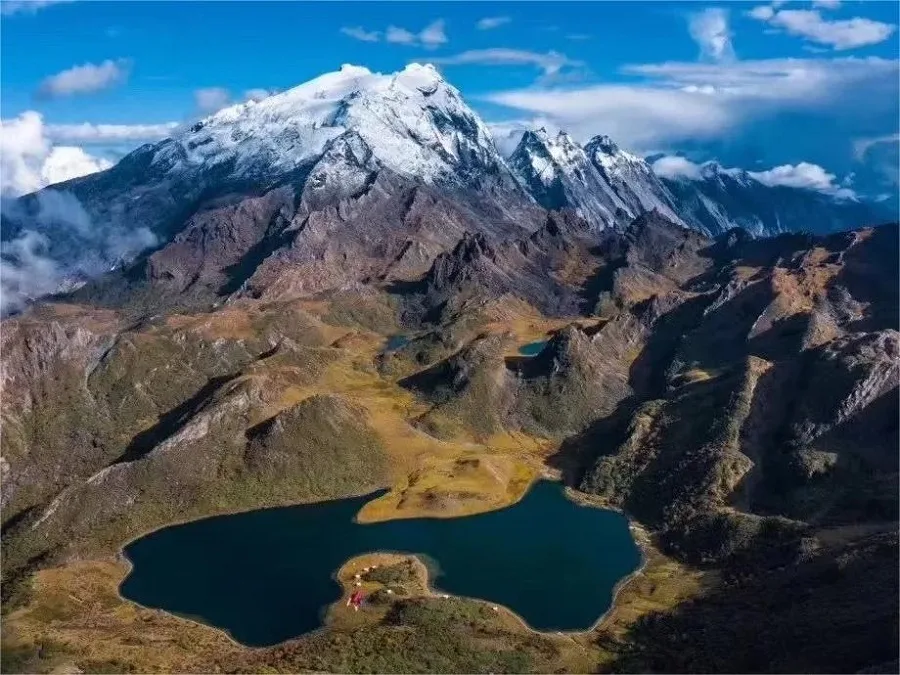Haba Snow Mountain (哈巴雪山), situated in the southeastern part of Shangri-La County, is a towering peak dramatically uplifted by the tectonic movements of the Himalayas and subsequent Quaternary structural activities. With its highest peak reaching an elevation of 5,396 meters above sea level and the lowest point at a mere 1,550 meters, Haba Snow Mountain boasts a striking contrast between its gentle upper slopes and steep, precipitous lower cliffs, creating a majestic and enchanting landscape.
The name “Haba” originates from the Naxi language, meaning “golden flower.” According to local folklore, Haba Snow Mountain and Jade Dragon Snow Mountain are considered brothers, while their sister, the Jinsha River, flows between them, forming the famous Tiger Leaping Gorge.
Haba Snow Mountain is a popular destination for mountaineering enthusiasts, attracting climbers from around the world. It is particularly suitable for novice climbers, with the best climbing seasons typically occurring from March to June and from September to December. Other times of the year may experience rainy or windy conditions, which are less favorable for climbing.
Beyond mountaineering, Haba Snow Mountain offers breathtaking natural scenery. It is home to a diverse array of flora, particularly rhododendrons, with various species flourishing at different altitudes. Dubbed the “mother of world gardens” by biologists, Haba Snow Mountain provides a stunning display of rhododendrons throughout its slopes, offering visitors a glimpse into the rich biodiversity of the region.
Table of Contents
- Basic Information
- Location and Transportation
- Map of Haba Snow Mountain
- Highlights of Haba Snow Mountain
- Vlog about Haba Snow Mountain
- Attractions near Haba Snow Mountain
Basic Information
| Estimated Length of Tour | 1 – 3 days |
| Ticket Price | Included in the ticket for the Tiger Leaping Gorge |
| Opening Hours | 24 hours a day throughout the year |
Location and Transportation
Haba Snow Mountain is located in the southeastern part of Shangri-La City, Diqing Tibetan Autonomous Prefecture, Yunnan Province, China, facing the Tiger Leaping Gorge across from Jade Dragon Snow Mountain. Here’s how to get there:
From Lijiang: Head to Lijiang Passenger Transport Station (No. 25 Kangzhong Road, Ancient Town District, Lijiang City) and purchase a bus ticket to Haba Village. Buses typically depart around 9:00 AM and the journey takes about 5 hours. The bus will directly reach Haba Village at the foot of Haba Snow Mountain.
From Shangri-La: Go to Shangri-La Bus Passenger Transport Station (No. 195 Worker’s New Village, Shangri-La City) and take a direct bus to Haba Village. The ticket price is approximately 30 yuan per person, and buses usually depart at 1:50 PM every day.
Upon Arrival at Haba Village: Proceed to the Base Camp: The journey from Haba Village to the base camp is typically a trekking route, but you can also choose to travel on horseback. The rental cost for horses is around 100 yuan per day. Please note that the trekking route may be challenging and requires a certain level of physical fitness and preparation.
Map of Haba Snow Mountain

Highlights of Haba Snow Mountain
A Sanctuary for Wildlife

Haba Snow Mountain, with its vast range of altitudes, creates a distinctive vertical climate that fosters a diverse ecosystem with a zonal distribution. This unique climate gives rise to various vegetation belts, including alpine frozen vegetation, alpine meadows, shrubs, fir forests, spruce forests, alpine evergreen broad-leaved forests, and dry-hot river valley shrublands. The mountain is teeming with a rich array of plant species, making it a botanical wonderland. Within its dense virgin forests, numerous rare and precious animals find their habitats, including the protected Yunnan snub-nosed monkey, wild ass, snow leopard, macaque, red panda, leopard, musk deer, serow, and muntjac, as well as black bears, brown bears, wild boars, masked civets, parrots, and various species of laughingthrushes. The diversity of habitats and vegetation zones supports a thriving ecosystem, offering ample opportunities for wildlife observation and conservation.
Frozen Cascades and Glacial Wonders

Around an altitude of 4,700 meters, the cliffs are adorned with hanging icefalls, resembling an exquisite symphony of the mountain’s pristine beauty. These hanging ice glaciers are the southernmost maritime temperate glaciers in China. The jagged peaks, knife-edged ridges, U-shaped valleys, and sheepback rocks are believed to be the traces left by ancient glaciers. The melting ice from ancient cirques accumulates into numerous glacial lakes, with the most famous being the Black Sea, named for its dark, ink-like waters. The lake is deep and mysterious, with its scenery changing with the seasons. Most intriguingly, a few howls by the lakeshore can summon sudden rains or even downpours, adding to the lake’s mystique. The Black Sea is also inhabited by a large number of snow fish, locally known as “baby fish.” When the temperature is right, these fish form a ring, swirling in shallow waters along the lake’s edge, creating a truly mesmerizing sight.





